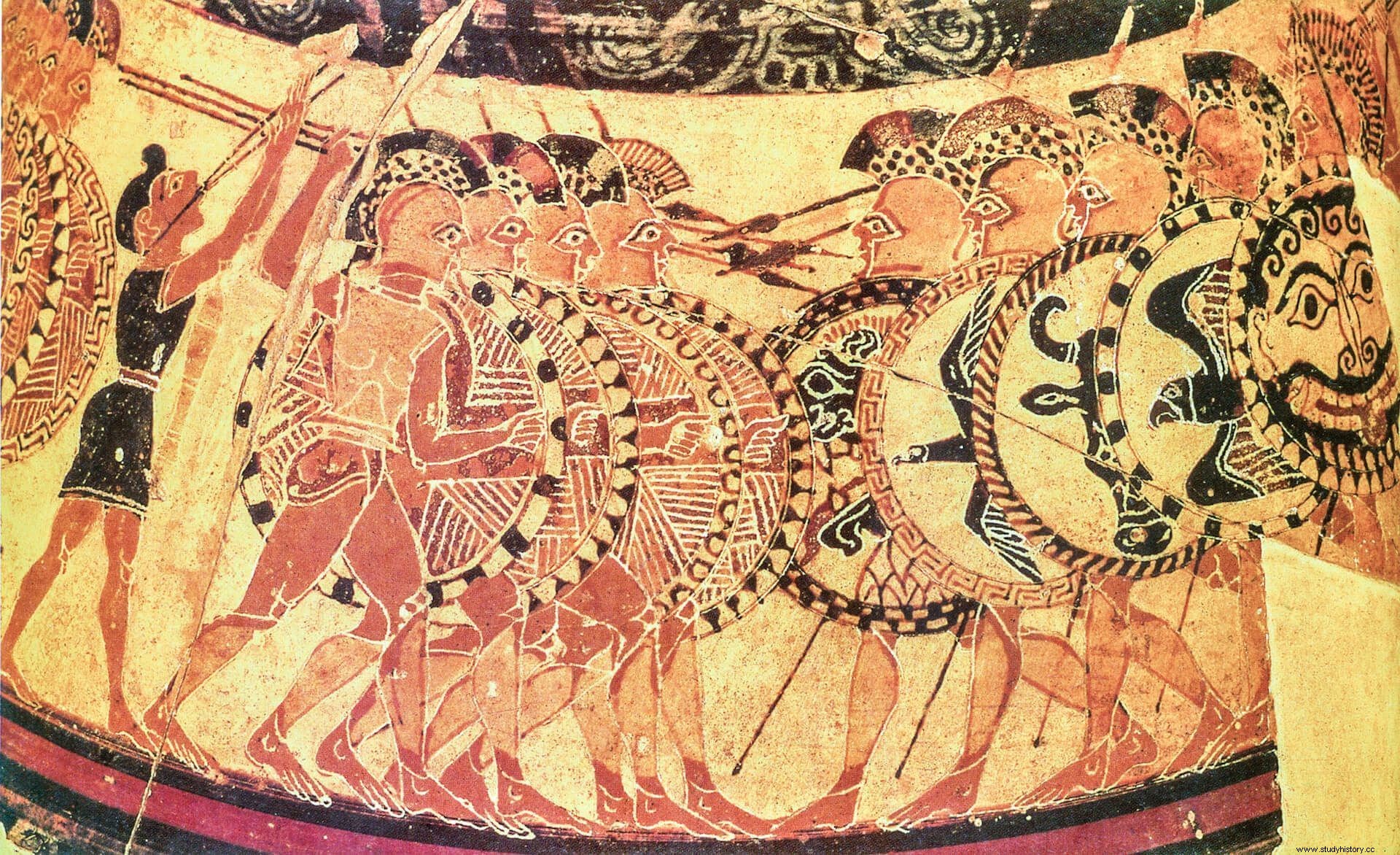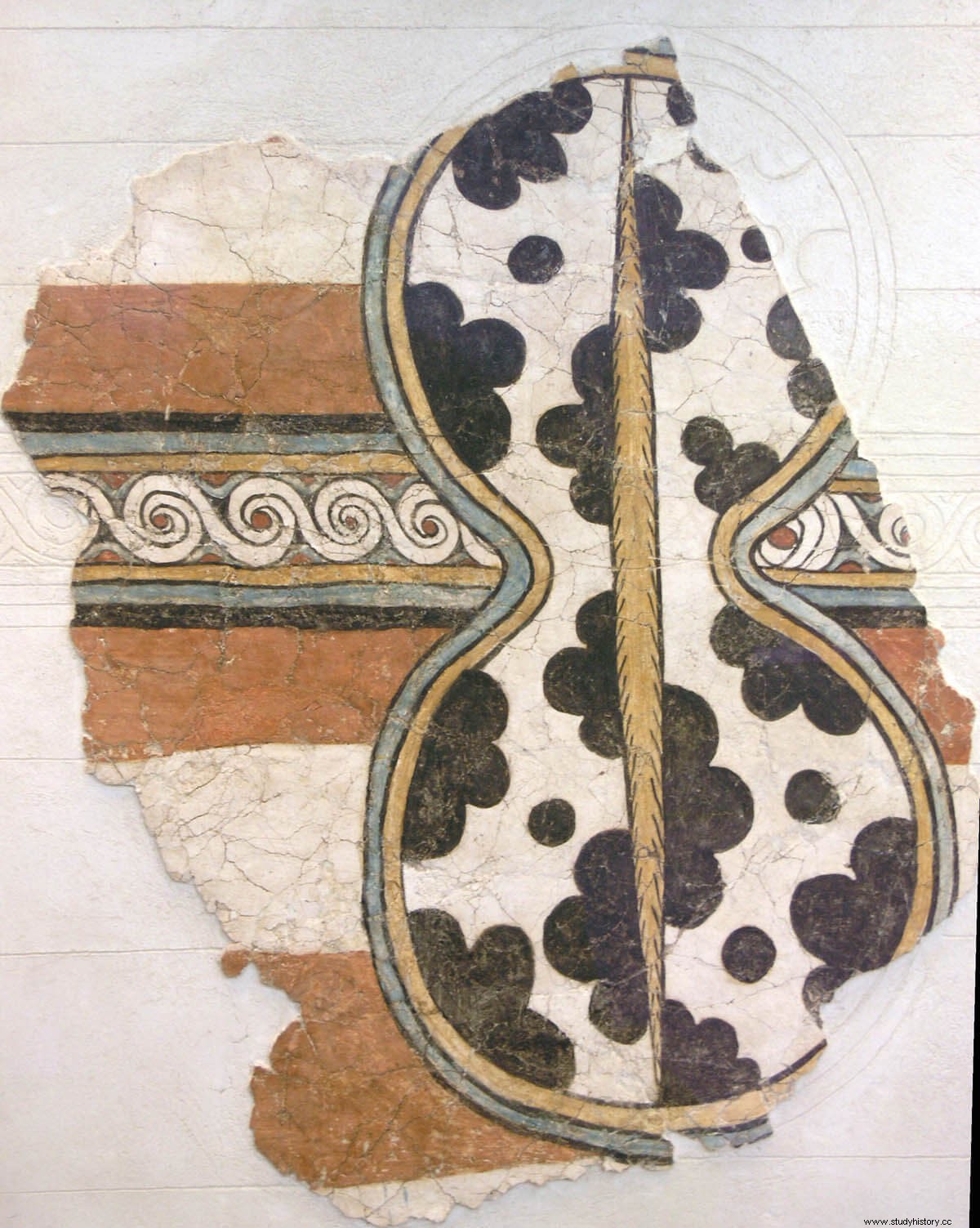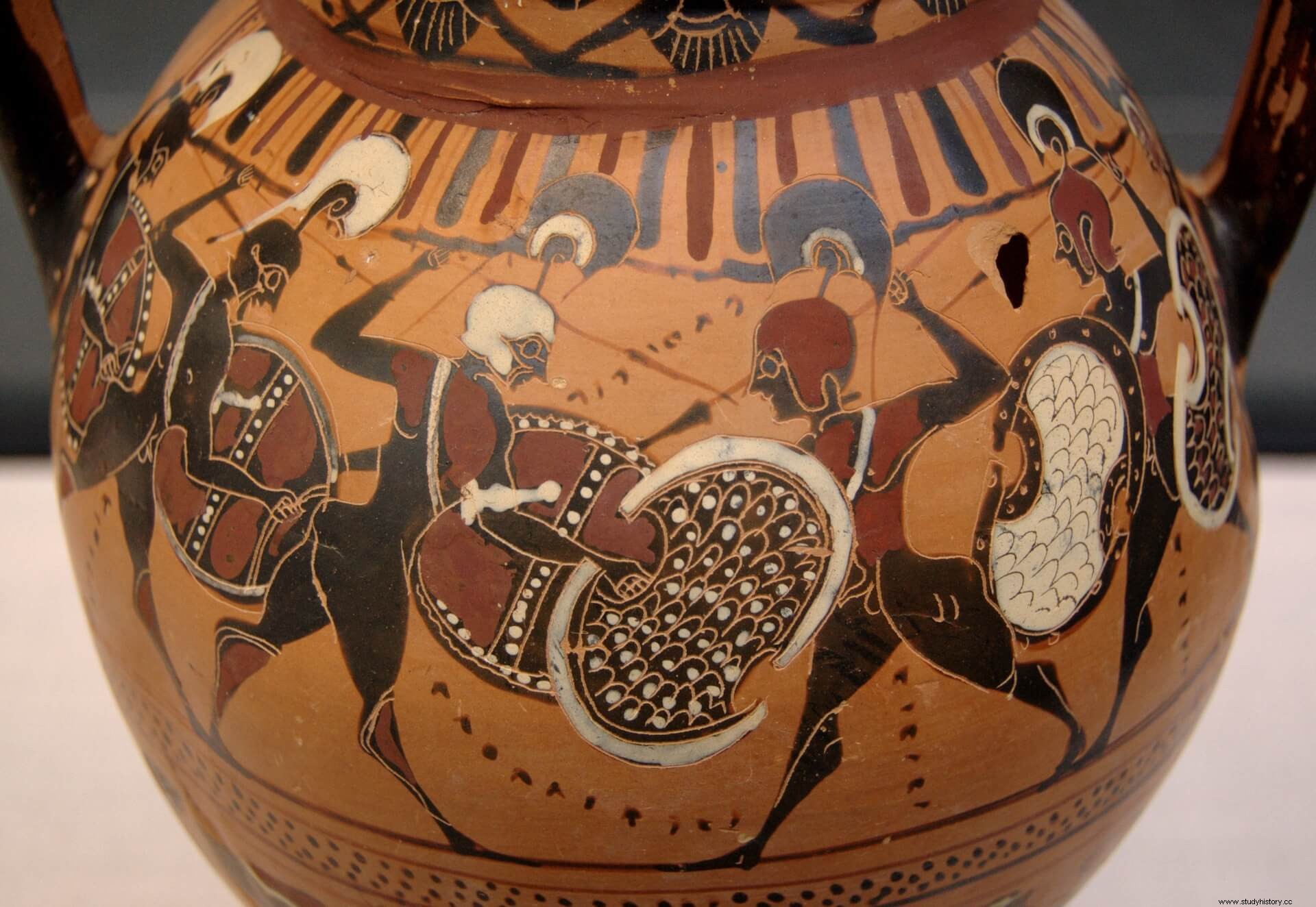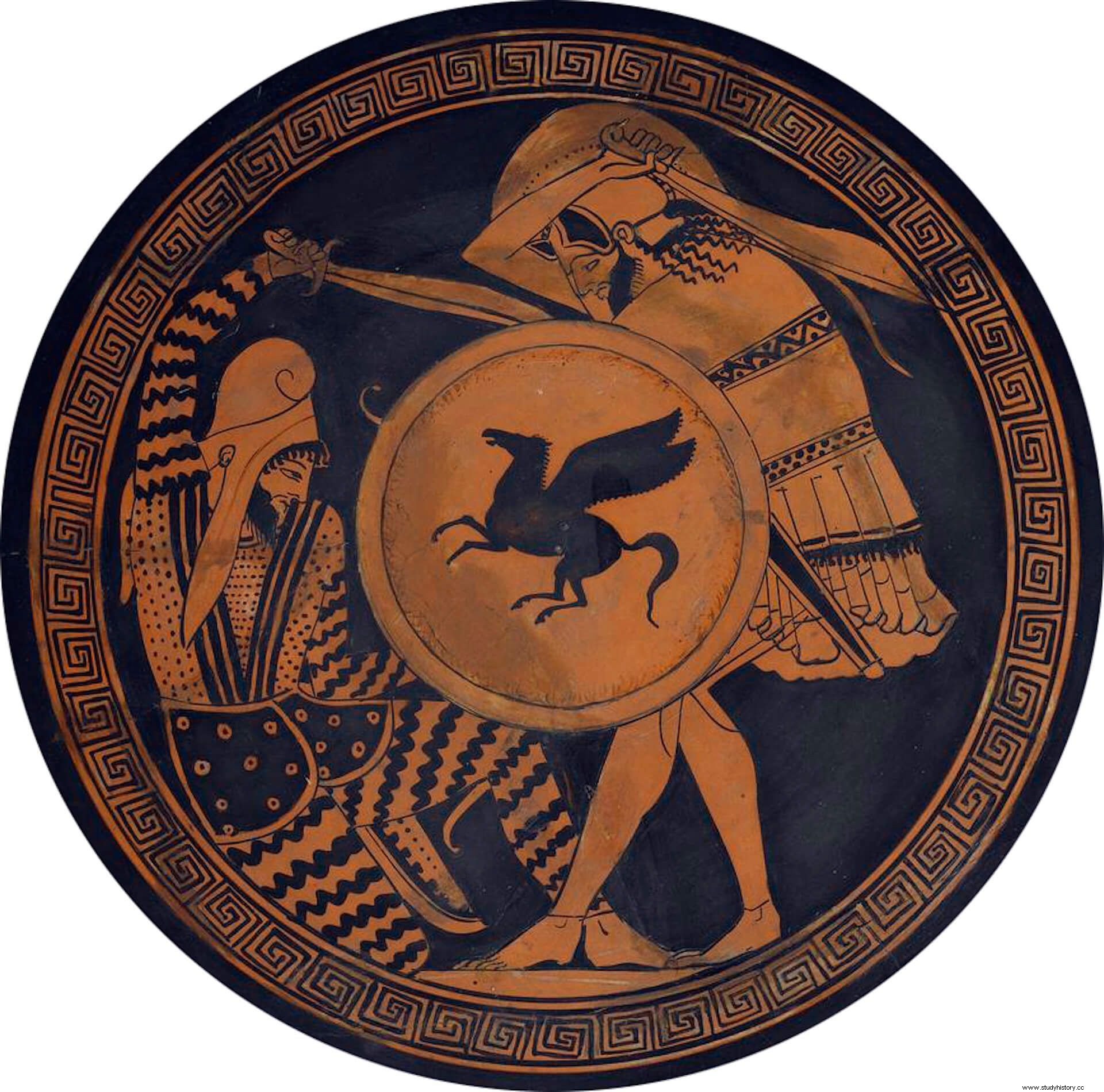
If we go back to the Age of Bronze , we will recognize the use of various types of Greek shield in the Aegean. As early as the 17th century B.C. C. the iconography certifies the use of huge rectangular shields that cover from the neck to the shins, and that probably correspond to Homeric allusions to "tower shields", such as the one used by the hero Ajax Telamonio. These shields would be equipped with a probably wicker skeleton on which an animal skin rested. From the sixteenth century a. C. –at least– a very striking shield is documented, with a silhouette similar to the Arabic figure “8” . This model, of great prestige throughout the Mycenaean era , could have been endowed with a symbolic meaning linked to the ethos agonistic, to the heroic competitive mentality typical of this culture. The use of these large shields, as well as long spears, seem to suggest a close combat mode, shoulder to shoulder, which advocates what centuries later will be called "phalanx". At the end of the period, in the thirteenth century a. C. and in correspondence with the supposed dating for the historical Trojan War, new shield models appear, in this case of small size; among them, some with a round silhouette, others in the shape of a Cypriot ingot (like an extended ox skin) and, finally, pelta shields , round but provided with a notch (a kind of "bite" on the edge). These changes seem to suggest a mutation in combat modes, perhaps towards looser formations and troops fighting in open order.

Then the famous “Crisis of 1200 a. C.”, which in the Aegean leads to the disappearance of social complexity, of the Eastern court States (the Mycenaean palaces). This opens the way to a Dark Age (sic ), whose name expresses the very little information we have about the period. We must wait until an advanced period of this phase when, in the Late Geometric (second half of the 8th century BC), the first ceramic representations of warriors appear. These appear armed with a very striking Greek shield, oval, large, and equipped with two large opposite lateral notches. This model is known today as “e45 ”, in honor of the cemetery of Athens in whose ceramic grave goods it appears represented. The fact that no archaeological evidence of them has been found has led some authors to suppose that they never existed except in iconography, and that they were fanciful. Thus, Phillip de Souza suggests that they could be leather shields and that this explains why no vestige has been preserved. Other authors, such as Fernando Quesada, propose that we find ourselves before an archaic memory of an ancient style of war, as a means to ennoble the lineage of the deceased, alluding to heroic deeds of the past, or of his ancestors. The resemblance of the Dipylon shield to the ancient shields of eight from the Bronze Age seems to be an argument in favor of this hypothesis, although the debate is far from settled.

The truth is that, coinciding with this same period (around the Late Geometric) Greek society experiences a remarkable development in all senses:demographic, economic and political complexity. This is when the city-states developed. (Athens, Sparta, Thebes...) around which, henceforth, the Greek world will revolve. It also coincides with the Greek colonizing effort in the central Mediterranean (Magna Graecia), and the founding of cities such as Taranto, Cumas, Syracuse, all of which would have an immense influence in the following centuries. And it is also at this time that the hoplite combatant model is developed:a citizen militia, whose members fight shoulder to shoulder in dense formation and are armed with a complex and expensive panoply in which the wide round shield called aspis . Its wide diameter ranged from 90-110 cm, its core was made of wood and it was equipped with a thin bronze sheet cover on the outside, more aesthetic than effective. In addition, it had a rim that allowed the combatant to rest the shield on the shoulder, thus relieving part of the weight, which could reach between 6 and 8 kg. But what was truly revolutionary about this model was its grip:if to date all Greek shields had been wielded thanks to a handle placed in the center, now the handle (antilabe ) had been moved to one side of the shield, near the edge. In the center, instead, stood a large brace (porpax ) through which the combatant passed his arm up to the height of the elbow. In this way, the shield was supported by three points, which ensured a firmer hold and distributed the blows of the enemy between the arm, the hand and the shoulder. This peculiar fastening meant that a large part of the shield was left over on the left side of the bearer, which is explained because it was designed to provide protection both to its bearer and to the warrior who formed on his left. Thus, it was in close formation that the aspis shone. in all its effectiveness. It also had some conspicuous effects:for example, the desire to take advantage of the protection of another's shield caused soldiers to close in on their partner to their right, which in practice meant that formations progressively reduced in width over time. throughout the battle. It will be this model of combat and shield, which will triumph on the battlefields for centuries (specifically, between the 8th and 4th centuries BC) and will give an immense military advantage to the Greek peoples over practically all of their opponents. This would be demonstrated in the overseas military expeditions –during the colonizing phenomenon– and, even more clearly, in the conflict with the Persian Empire, whose expeditions in the years 490 BC. C. and 480-479 a. C. will end in resounding failure and humiliation in the face of the effectiveness of the hoplite war machine .

In the 4th century BC. C., however, a new model of combatant is introduced, which little by little will displace the hoplite:it is the pikeman. To hold the –increasingly longer– pica (or sarissa ) the effort of both arms is necessary, and consequently the Greek shield can no longer be grasped with the hand by means of the antilabe , as was the case before. To solve this, an equally circular shield was introduced, but much smaller in size and held by a strap from the neck. Equipped with a pike and a small shield, the new combatant is arranged in extremely dense and deep formations. It is called Macedonian phalanx , which as we can see is nothing like the hoplite phalanx. The superiority of the new model is repeatedly demonstrated, and it will be the trump card of the nascent power of the kingdom of Macedonia in the time of Philip II. The Macedonian phalanxes are also the ones that make up the nucleus of the army of his son, Alexander the Great, a contingent with which he will achieve brilliant victories that will immortalize his name in the pages of history. In this way, it can be seen how the analysis of a simple and modest object, such as the Greek shield, can offer us important clues for our knowledge of the universe that surrounds it.
